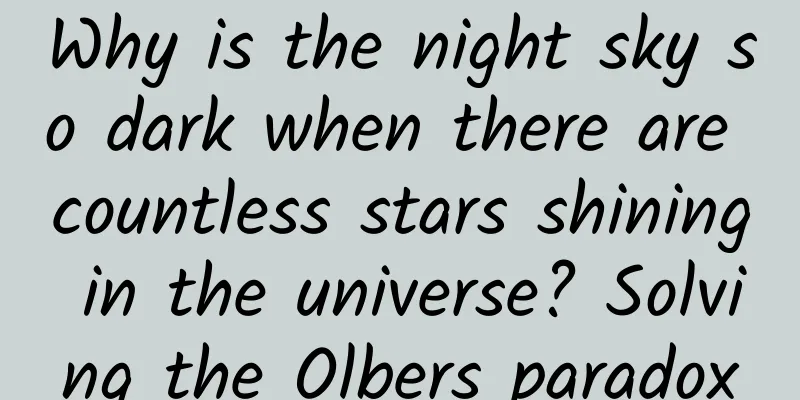Why is the night sky so dark when there are countless stars shining in the universe? Solving the Olbers paradox

|
On a clear night, we look up at the sky and see a sky full of stars, but between these stars, there is darkness. These stars are like gems inlaid on black velvet, shining brightly. This is no longer a strange phenomenon, but what makes humans different from other animals is that they have a smart brain. So many people are still pondering this phenomenon that has been seen for thousands of years: why is the universe black? Olbers' paradox Modern scientific observations and research have given us enough knowledge about the universe. It has become common sense that the universe is very large. The observable universe contains trillions or even tens of trillions of galaxies. Our Milky Way is just one of the many spiral galaxies, and the sun is just an ordinary star in the Milky Way. The Milky Way has a diameter of 200,000 light years and contains 200 billion to 400 billion stars. Our Earth is a medium-sized planet in the solar system. The sun shines on the Earth every day, bringing us light, so it is bright during the day. But in space, since every star is a sun, there are hundreds of billions of suns shining even in the Milky Way, so why is the background of space still pitch black? In ancient times, people had a shallow understanding of the universe and regarded the stars as gods, so they certainly would not think about this problem. But in the age of science, wise people began to wonder. In 1610, astronomer Kepler raised this question, and he was considered the first person to raise such a question in a scientific way; in 1823, German astronomer Olbers raised this question systematically, so people called this question "Olber's paradox." The core idea of Olbers' paradox (also known as the night darkness paradox or the luminosity paradox) is that if the universe is in a steady state and infinite, it should be bright at night, not dark. This idea is based on the absolute cosmology that has always dominated human thought, which believes that the universe is born like this, has no beginning, no end, no boundaries, and the speed of light is infinite. Since the emergence of science in ancient Greece, the absolute cosmology has become the dominant ideology. This concept has not wavered until Copernicus discovered the heliocentric theory, Galileo observed the hugeness of the universe, and Newton discovered gravity. According to this view, the universe is infinite, without beginning or end, so the number of stars is infinite, and the speed of light is infinite. Once it is born, it fills the universe. In this way, the light emitted by the stars will remain in the universe, so the universe should be bright. But in fact the universe is dark, which is a paradox and therefore a paradox. Now, science has explained this problem very well. There are three main reasons why the universe is dark: first, the universe is not static, but dynamic; second, the speed of light is finite and constant, so the propagation of light also takes time; third, the universe is too big and empty, and there is no matter to fill it, so the light of stars is far from enough to illuminate these spaces. The Universe is Expanding, and It Has a Beginning and an End At the beginning of the last century, the scientific community was in turmoil, and breakthroughs were made in the observation and discovery of the universe. The most typical representative of these breakthroughs was a legendary figure who discovered and created a series of theories that completely subverted human concepts. This person was the great scientist Einstein. Einstein's special theory of relativity and general theory of relativity, based on a series of discoveries in contemporary science, such as Edwin Hubble's discovery of the expansion of the universe and the Michelson-Morley experiment's discovery of the constancy of the speed of light, demonstrated the relativity of space and time and denied the absolute view of space and time in Newtonian mechanics. Since then, the view that the universe is finite, is constantly expanding, and has a beginning and an end has gradually become the mainstream cognition of the scientific community and the world. Through various scientific methods of observation and modeling, people believe that the universe originated about 13.8 billion years ago and has gone through three stages: inflation, deceleration and acceleration. Now it is in the stage of accelerated expansion. According to the Hubble constant, the expansion rate is much greater than the speed of light. According to the expansion rate of the universe and the Hubble constant, scientific modeling and calculations show that the radius of the observable universe is about 46.5 billion light years. The observable universe is only the universe that humans can understand and observe in the future. There is still a universe outside the observable universe, and its scope is currently unpredictable. From the moment of time, that is, after the Big Bang, it took hundreds of millions of years for stars and galaxies to form, and these galaxies are rapidly separating and moving away from us as the universe expands. In this way, the distance between galaxies and stars will become larger and larger, the density in space will become sparser, and the light will become weaker and weaker. This is the first reason why the light from stars cannot illuminate the entire universe. Olbers' paradox actually questions the absolute universe view and supports the relative dynamic universe view. The speed of light is limited, and it takes time to propagate If the speed of light is infinite, then starlight will suddenly fill the entire universe, so the universe is bright. However, Galileo has questioned the infinite speed of light. After hundreds of years of unremitting efforts and countless experiments by scientists, they finally concluded that the speed of light in a vacuum is 299792458 m/s (meters per second). Moreover, the Michelson-Morley experiment confirmed that the speed of light is the same in different inertial reference frames and in different directions, such as light coming along the direction of the earth and light coming against the direction of the earth. Therefore, the speed of light is constant. Since the speed of light is finite and constant, it takes time for starlight to reach a place after it is emitted. The essence of light is electromagnetic waves. Human eyes can only see visible light, which is only a very narrow band in the entire electromagnetic spectrum, ranging from about 780 to 380nm. And light waves have the Doppler effect. What is the Doppler effect? It means that as the wave source moves away from the observer at high speed, the wavelength will be stretched, and when it approaches the observer at high speed, the wavelength will be compressed and shortened. The Doppler effect of light waves is to produce the spectral redshift and blueshift effects. The expansion of the universe is much greater than the speed of light, so when humans observe the light of distant galaxies, a redshift effect will occur. The farther and faster the starlight is moving away, the further it moves out of the wavelength range of visible light and becomes invisible to the human eye. Therefore, the light waves we see with our naked eyes in the universe are only a small frequency band of electromagnetic waves, and we cannot see most of the frequency bands, so the light of stars cannot fill the entire universe. As stars get farther away, their brightness decreases We know that the light seen by the human eye includes light emitted by the light source itself, such as stars, fire, lamps, etc.; there is also light reflected by objects. For example, all objects other than the light source, such as the moon, people, houses, trees, etc., are seen by relying on reflected light. In space, each star is too far apart, and in the vast space, there is a vacuum and there are almost no particles to carry and reflect light, so the light of stars cannot illuminate the entire space at all. Our Earth is only 150 million kilometers away from the Sun and is wrapped in the atmosphere. When sunlight reaches the Earth, it is reflected by the atmospheric particles, so we can see the blue sky and white clouds, as well as bright light in the shade. If we are on the moon, since there is no reflection from the atmospheric particles, the places where the sun shines will be bright and white, while the places where the sun does not shine will be pitch black (of course, lunar rocks and other objects will also reflect light into the shadows, but without the atmospheric particles and dust, it will be much darker). In fact, the sun's light doesn't shine far. If you go to Pluto, it is less than 6 billion kilometers from the sun on average, only 0.00063 light years away. The sun you see there is only the size of a star. Although it is still bright, it is only 291 times brighter than the full moon. On Earth, the sun's brightness is about 700,000 times that of the full moon. When looking at the brightness of the sun from a distance of 1 light-year, the apparent magnitude is only -2.71 (the smaller the value, the brighter the apparent magnitude). When looking at Venus from Earth, it can reach -4.6 magnitude, and when looking at Jupiter, it can reach -2.9 magnitude. In other words, when looking at the sun from a distance of 1 light-year, it is not as bright as Venus and Jupiter from Earth. If looking at the sun from a far point, at Alpha Centauri, the nearest star to the sun, which is 4.3 light-years away, the apparent magnitude of the sun is only 0.43 magnitude, which is not as bright as the 0.01 magnitude of Alpha Centauri A. Stars are sparse, and without particles in space to reflect them, they cannot light up. How sparse are the stars in space? Let's take the Milky Way as an example: the Milky Way has a diameter of about 200,000 light years. If we use the average thickness of 5,000 light years to calculate the volume, the average distance between 400 billion stars is about 7.32 light years. With such a sparse starry sky, it is completely impossible to fill it with light with the little energy from stars. More importantly, the entire space is in a highly vacuum state. Except for some places where dust and nebulae are concentrated, there are only extremely small amounts of particles floating in most of the space, which cannot absorb or reflect light at all. The distances between galaxies are even greater, measured in hundreds of thousands to millions of light years, so this huge space is even more vacuum. It is generally believed that the density of the universe is only one particle per cubic meter on average. This density is calculated by the ratio of all particles in the universe (including all galaxies and stars converted into particles) to space. Therefore, the emptiness of the universe is beyond human imagination. In places where cosmic dust is concentrated, we can see the reflection of nebulae, and telescopes can take pictures of colorful and bizarre nebulae, such as the Pillars of Creation (see the picture below). In fact, the density of these nebulae is also very small, with only dozens to hundreds of particles per cubic centimeter, while on the highly vacuum surface of the moon, the number of particles reaches tens of thousands per cubic centimeter. However, these nebulae are very dense in the extremely vacuum space and have a huge range, often several light years or even hundreds of light years. The total amount of these particles is very huge, so nebulae are the mother of the birth and formation of new stars. This is why we see stars in the sky at night, but the background is pitch black. Modern cosmology believes that because the universe is expanding at an accelerating rate, the starry sky will become increasingly sparse, the background will become increasingly dark, and the universe will eventually die in heat death. Of course, this time will be very long, so long that humans simply cannot endure it, and it will have long disappeared. Do you understand? Welcome to discuss, thank you for reading. The copyright of Space-Time Communication is original. Infringement and plagiarism are unethical behavior. Please understand and cooperate. |
<<: Experts reveal the truth about 9 major rumors about osteoporosis
Recommend
Xiaohongshu promotion method and Xiaohongshu ranking skills!
Today I will talk about how to promote Xiaohongsh...
How to write “textured” copy? Here are 3 ways
Copywriting with texture can give people enough r...
How does Baidu bidding bring you business?
Pay-per-click marketing is a way to bring traffic...
The Internet in 2016: Where has all the traffic gone?
The trouble with public accounts: disappearing re...
The Journey to Psyche Exploration Begins! The Target is More Than Just the "Golden Planet"
At 22:19 Beijing time on October 13, the US Falco...
How does product operation achieve user fission?
Invitation is one of the ways to achieve product ...
Wu Daguan: The never-ending "Chinese Heart"
Wu Daguan is a famous aviation engine expert in m...
How much does it cost to join the Changge Parent-Child Mini Program? Changge Parent-Child Mini Program Franchise Price Inquiry
Why join the WeChat Mini Program Development Comp...
NIO reports third-quarter net loss narrows
Just now, NIO released its third-quarter financia...
Does your brain start to age at age 20? To slow down brain aging, just do this!
Author: Xu Jun, Chief Physician, Beijing Tiantan ...
What is the cost of developing a mini program online mall? How much does it cost to develop a mall mini program?
The e-commerce industry has a history of more tha...
What are the biggest risks facing companies in the face of the rapid development of artificial intelligence?
AI has the potential to bring “significant benefi...
Apple is making major adjustments to the iOS 14 interface: new design, new operation methods, new gameplay
According to the latest report from foreign media...
Win10 photo editor has been greatly revised: born for goddess photo editing
Microsoft Windows 10 has always been mediocre in ...









